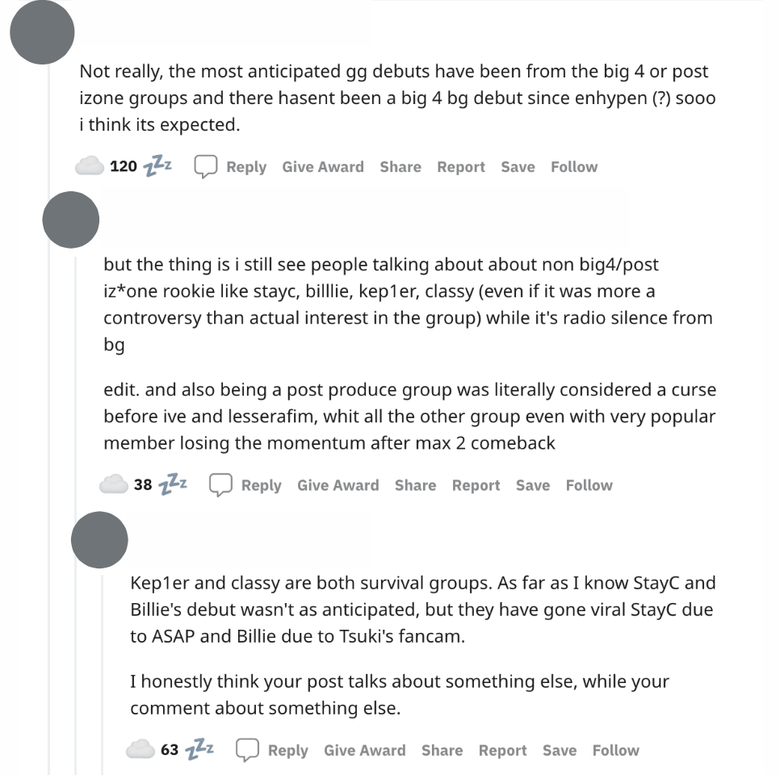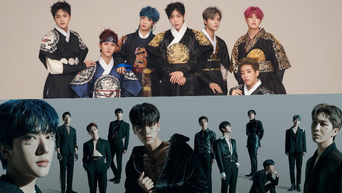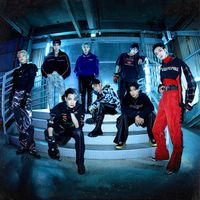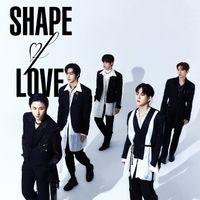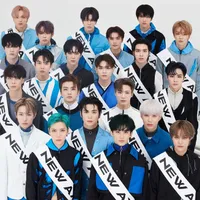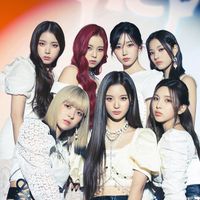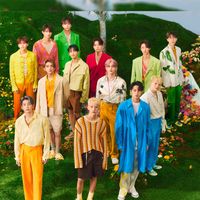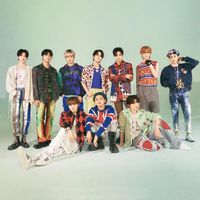Lately, girl groups have been gaining recognition in the K-Pop scene in a way that they haven’t in a while. Whilst boy groups have been considered the face of K-Pop for a period of time, with certain girl groups receiving the same recognition; some girl groups have been lacking the same amount of much-deserved recognition. This has started to change recently and has hence sparked a discourse among K-Pop fans about whether girl groups are becoming more popular than boy groups. Whilst one can argue that girl groups have always been popular in K-Pop, as they have, at one point in K-Pop fan culture boy groups held a generally larger stake of real estate in the hearts of fans and the general population. When looking at statistics like album sales and fandom sizes, boy groups are generally seen as being more popular than girl groups. The debate is not to say that boy groups are not doing well. In fact, it is the opposite. Boy groups are seeing growth in their sales and fandoms, as well. However, there is a significant and obvious spike in the overall popularity of girl groups nowadays. Naturally, groups such as Girls’ Generation, TWICE, BLACKPINK, and more have always had large fandoms, but fans have noticed that the spectrum of girl groups receiving attention is steadily expanding. Let’s take a dive into this debate and get fans’ opinions on the matter. Note: For the sake of this article the word ‘rookie’ refers to idols who debuted in 2021 and 2022.
What proves popularity in K-Pop?
The definition and determination of popularity in K-Pop
Firstly it’s important to determine how popularity can be measured in the conversation regarding K-Pop. Popularity (in general) is defined as the state or condition of being liked, admired, or supported by many people. Fans often determine popularity in K-Pop by fandom size, brand reputation (note: this refers to the general reputation of idols among brands and not necessarily the well-known ranking), album sales, digital streams, and more. However, with all of these factors considered, popularity can still be seen as a subjective matter depending on how it is substantiated in a conversation.
Fans’ desire to prove the popularity of their idols
Some fans may use certain data collections to substantiate their claims about their favorite artist’s popularity. For example, Brand Reputation Rankings with data provided by the Korean Business Research Institute are often used among K-Pop fandoms to substantiate their opinions on the popularity of their favorite K-Pop artists. This is especially the case in discussions where fans compare within the same gender.
Popular K-Pop groups vs. Trendy K-Pop groups
However, other fans often feel that these kinds of charts and rankings are an unfair representation of popularity and simply reflect trends. A trend is defined as a topic being discussed by many either on or off social media, particularly during a certain time period. One could argue that trends are a short-lived sensation and popularity is a long-term sensation. These rankings are not necessarily representative of the popularity of girl groups vs boy groups, as they are divided into gender-exclusive charts, but the frequent use of these stats in debate show fans’ desire to have a means to measure the popularity of their idol. They also show the contrast between the concepts of ’trendy K-Pop groups’ and ‘popular K-Pop groups’. On one hand, trends are part of what contribute to the popularity of a group and identifying it. So, the consideration of trends is not to be discarded in this conversation completely. Virality on social media, for example, is one of the ways that has made it apparent that girl groups are the moment in 2022. If a K-Pop group goes viral, the number of K-Pop fans who are exposed to their content increases and those fans become more likely to scratch their curiosity about the group; thus converting into the growth of their fandom and popularity. For example, Billlie became a better-known group despite being from a smaller company thanks to a number of viral moments on top of their existing talent and continuously impressive comebacks. Whilst their talent would’ve inevitably gained them the recognition, a viral moment certainly speeds up the much-deserved spotlight. Being trendy has become a huge piece of impact in the journey of building and determining the popularity of many K-Pop groups. To that point, some fans have pointed out that the majority of the songs that have gone viral in 2022 have been from girl groups. For example, songs like IVE’s title tracks ‘Love Dive’ and ‘After Like’, TWICE NaYeon’s ‘POP!’, and NewJean’s ‘Attention’ and ‘Hype Boy’ were just a few of the songs mentioned. In perspective of trendiness, one common factor between all of these songs is that they all did exceptionally well on social media platforms like TikTok and Instagram Reels, for instance. The same can be said for boy groups, however. Songs such as ZICO’s ‘New Thing’, TREASURE’s ‘DARARI’, PSY (ft. BTS’ Suga)’s ‘That That’, and ENHYPEN’s ‘Polaroid Love’ also experienced similar levels of virality on social media, for example. Viral moments and even general social media following say a lot about a group’s popularity. Even companies such as Space Oddity who created the “K-Pop Radar” data that measures the popularity of K-Pop acts and the size of their fanbase in real-time, use factors such as a group’s number of social media followers, their real-time view counts on YouTube, number of fan cafe members, and more to determine the group’s popularity.
The popularity of boy vs. girl groups throughout the generations
The ratio of popularity in the 1st, 2nd, and 3rd generations of K-Pop
As we’ve mentioned earlier, there have been many eras throughout K-Pop when male artists and K-Pop groups held the bigger stakes of real estate in the K-Pop industry, with the exception of many impactful girl groups. For example, if we look at the top 10 of K-Pop Radar’s “Badge Board” and the groups with the most overall badges ever, one can tell that male artists have been the most prominently popular for a long time in K-Pop. This chart shows the collection of badges groups/artists have received over the years as their music video reached certain viewcount milestones. Note: This screenshot was taken on Oct. 27, 2022 (22:12 PM KST). Although some of the top acts are legendary girl groups, the majority of the board is filled with male acts. Excluding 4th generation K-Pop group ITZY, 6 male artists/groups make up the list compared to 3 female artists/groups. Although it takes a while to accumulate these kinds of achievements, a chart like this with exclusively 4th generation idols or even current rookie idols (who debuted from 2021-2022) may show a different gender ratio in the future. Similarly, when looking at K-Pop groups with the most first week album sales, majority of the artists holding the top spots are male. BLACKPINK managed to enter the top 10 this year with their album “BORN PINK”, with aespa as the only other female artist in the top 20. Note: This data was screenshotted at the end of October 2022. You can check out the full frequently updated list (currently with 266 rankings) here. Excluding BLACKPINK, TWICE, IU, Girls’ Generation, Red Velvet, and more, the other female artists in the top 200 of the list are mostly fourth generation girl groups. Artists like aespa, IVE, (G)I-DLE, LE SSERAFIM, ITZY, NMIXX, NewJeans, Kep1er, STAYC have all managed to secure spots in the top 200 best first week album sales record chart.
The ratio of popularity in the 4th generation of K-Pop
One could say that it is easier to notice a shift in who is popular in the 4th generation, due to it being the active era during a hyper-technological age. Partly due to this, many fans have recently shared the belief that (as far as they can tell) boy groups in the 4th generation (particularly ones that have debuted more recently) have not made the same impact as 4th generation girl groups. They have noticed that whilst many 2nd and 3rd generation boy groups remain at the top of their popularity, many 4th generation boy groups have not been able to achieve that level of popularity yet; according to fans. Again, we have to reiterate that this does not mean that boy groups are not popular. One can’t deny the impact of 4th generation boy groups such as Stray Kids, ATEEZ, TREASURE, ENHYPEN, and more, for example. To that point, many fans have noticed that whenever this discourse is brought up, the girl groups that are mentioned as popular over boy groups are rookie girl groups. This brings into question what is happening with the popularity of rookie boy groups as they have supposedly become less anticipated than girl groups in recent years. Several fans have shared the same sentiments, wondering what it is that is putting rookie girl groups abover rookie boy groups and pushing them to the forefront of the 4th generation.
Fan arguments against the popularity of girl groups
The longevity of girl group popularity is in question
The reason that there might be so much differentiation between girl groups and boy groups within K-Pop, might be because they are marketed so differently from the get-go. Some K-Pop industry officials have confirmed that girl groups are often marketed to have more general appeal. Whereas, boy groups are often marketed to have a more dedicated fanbase. This is particularly how boyfriend material marketing came to be in K-Pop, for example. As a result, some fans have pointed out that girl groups have more casual fans due to their mass appeal, bringing the depth of their popularity into question. A casual fan is someone who only listens to the group’s music and is not necessarily interested in anything else regarding the artist, but may support them in more endeavors without committing too deeply. This fan argues that whilst both girl and boy groups are doing well, girl groups are seeing a new-found popularity because they appeal to more people, which is a good thing. Depending on a fan’s perspective, they may argue that popularity speaks to the reach one has even outside of their own fandom. It doesn’t necessarily have to do with the size of their fanbase or other factors. This goes to show that popularity’s definition is fluid depending on one’s viewpoint. Whilst some fans credit girl groups’ popularity to having a larger mass appeal due to casual fans, some fans believe that the suggestion that they are more popular is disproportionate. These fans often believe that having mass appeal doesn’t translate directly into a group’s success. They also argue that even if girl groups are more popular than boy groups, it will be a short-lived K-Pop era before boy groups takeover again as the popularity lacks longevity. For this reason, some fans feel that the recent statement that has been rotating in K-Pop about girl groups becoming more popular than boy groups is exaggerated. They use the point that despite having larger appeal, when it comes to touring (for example), the girl groups might not compare to boy groups who have dedicated fans who will fill out and sell out concert venues for them every time. However, touring statistics may not be a factor that some fans consider when thinking about popularity; proving once again that popularity factors are dependent on how someone defines it. Additionally, groups such as TWICE, (G)I-DLE, and BLACKPINK are well-known for selling out tours to the point where they have to add additional stops. It is also less common for rookie girl groups to go on tours than it is for rookie boy groups. So, one could argue that the above statement is not based on a lot of comparable data.
Affiliation and demand: contributing factors of current girl groups’ popularity according to fans
Another reason that has been cited by fans as the cause of this take being disproportionate is, for one, the backing behind a certain idol. Some fans believe that a group’s agency must always be considered when speaking about popularity as it may come easier for some and not for others. For example, this fan has mentioned how many of the girl groups that are considered popular right now are from big 4 companies, consist of former IZ*ONE members, or are products of a Mnet survival show. All of these factors are considered to be an almost sure guarantee of a group’s success by fans. Due to a company’s abundant resources or, in the latter case, due to the popularity of the former group/show and thus existing fanbase; fans believe that a group can have an advantage in the industry. These groups include groups like LE SSERAFIM, IVE, NMIXX, Kep1er, and more. However, this opinion in itself can be seen as disproportionate because the other popular girl groups at the moment are from smaller/newer companies, and yet have managed to make a big name for themselves. Their debuts may not have been as highly anticipated as the groups mentioned above but they were still impactful. For example, groups like STAYC and Billlie are popular regardless of their starting point.
The possible reason for the decline in boy group popularity
Other fans also consider that newer boy groups are not as popular because 3rd generation boy groups are still extremely popular and thus there is less opportunity for boy group fans to get into new boy groups as they are too busy supporting existing ones. Many 3rd generation groups have managed to overcome the 7-year curse and maintain their popularity (and expand it) further. Groups such as BTS, SEVENTEEN, NCT, MONSTA X, and even groups where the members have all left their original company but not disbanded like GOT7 are still ever-popular. This implies that it could simply be an issue of supply and demand. What’s your take on this? Leave a comment with your thoughts down below!
Is there a need for one gender of artist to be considered more popular than the other at all?
Despite this becoming a huge debate in K-Pop, many fans do not see the point in this discourse at all. Some fans do not understand why there is such a desire to separate the beautiful world of K-Pop into two sides that are mutually exclusive. Therefore, many fans feel that K-Pop should not be as competitive or as much of a popularity contest, and that fans should be allowed to appreciate any artist and their success without putting others down. What do you think? Do you reckon that girl groups are becoming more popular than boy groups? Let us know your thoughts on this topic in the comments. The Evolution Of K-Pop Girl Group Concepts Over The Years: From Cute To Girl Crush, And Everything In Between KPOP STORIES|Oct 14, 2022 Fans Debate The Standing Of Non-Asian Idols In The K-Pop Industry: The Who, Why, Where, And How FANBUZZ|Jul 4, 2022 How K-Pop Marketing Trends Have Changed Over The Years Using Boy Groups As A Case Study FANBUZZ|Jun 8, 2022








